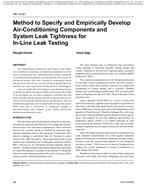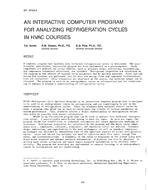Indoor air quality in the nonoccupational environment is of increasing concern because of the effects of escalating energy costs, reduced ventilation and the introduction of new and stronger sources of contaminants. Current knowledge is based on a relatively few cases of excessive exposure with serious consequences, on complaints in problem buildings, and on studies in the occupational environment and epidemiological studies of air pollution in the outdoor environment. Because of the diversity of sources, source strengths, air change rates and individual sensitivity of the occupants, it is difficult to make estimates of the total impact of indoor air contaminants. The effects range from acute eye and upper airway irritation and headache from cigarette smoke or formaldehyde and other organic vapors to the lowering of the defense mechanism against infectious diseases and an increased risk of carcinogenesis from inhaling tobacco smoke, asbestos fibers, or radon.
Citation: ASHRAE Transactions, 1983, vol. 89, pt. 1B, Atlantic City, NJ
Product Details
- Published:
- 1983
- Number of Pages:
- 7
- File Size:
- 1 file , 750 KB
- Product Code(s):
- D-AC-83-10-3


